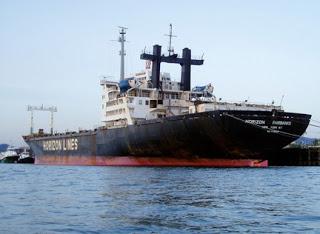
Invasive species continue to pose problems around the world - from relocated fish and land animals to plants to even infectious diseases. In the oceans, invasive species can prove to be both disruptive to the marine environment and a potential hazard to humans as well.
Two recent scientific studies, one in Emerging Infectious Diseases and the other in Marine Pollution Bulletin, looked at the issue of ballast water that is taken in and released by tankers and freighters in ports all over the globe. This exchange of water to maintain a safe balance to the ship as it loads or unloads its cargo has introduced a variety of unwelcome guests including mussels, seaweeds and algae, and even cholera.
Sometimes the ballast exchange takes place in deep enough water so that its contents are sufficiently dissipated. But in shallower water, pathogens as a product of urbanization and sewage can either come aboard or be expelled and soon brought into shore via swells and currents.
One solution is to treat the ballast water on board the vessel. However, ports and cities are then dependent on the ships having the proper equipment and using the methods effectively to do the job. The other possible approach is to develop an onshore treatment process wherein the ballast water is pumped ashore for treatment and then pumped back to the ship as needed, rather than having the entire ballast exchange take place in open water. A better idea perhaps on paper, but it requires considerable investment in equipment and the design of each port must be carefully studied to determine if and where the systems can be installed.
However, compared to the financial losses incurred by invasive species from disrupted commercial fisheries to clogged water inlet/outlet pipes to disease outbreaks, the costs of advanced onshore treatment systems could prove to be a bargain.
Another study, written up in Conservation Letters, examined the issue of whether consuming an invasive species as a possible food source could prove to be an effective means of populations. Why beat it, just eat it.
This has been the approach taken in areas where the Humboldt squid has moved in, shifting the fishermens catch from local commercial fish stocks to all squid. And in the Caribbean and the eastern Florida coast, where the lionfish population has exploded recently from its accidental introduction several years ago, attempts are being made to develop a taste for the South Pacific reef fish’s meat among local sharks and even with the human population (a bit tricky to prepare but, I have been told, quite tasty).
The study, however, notes the dilemma that this approach can cause through the production then of a viable market. An invasive species could turn out to be a commercial success and where there is commercial success there can be the desire to maintain or even expand it. Suddenly, the invasive species becomes a profitable friend to man - at the expense of the marine environment it is affecting. The ultimate insult would be that an effort could be made to protect the species for the sake of its commercial value - a complete reversal of the original concept of reducing or eliminating the population through harvesting.
The introduction of commercial enterprise and consumption in the control of any invasive species must be undertaken with a clear understanding by government and regulatory agencies as to the underlying purpose of taking such a step. Either supported by scientific research or even just the common sense that every invasive species is a Pandora’s box of unknown consequences, decisions must be thoughtful and well-informed.
Source: Emerging Infectious Diseases 18(10)
Source: Marine Pollution Bulletin 64(11)
Source: Conservation Letters 5(5)